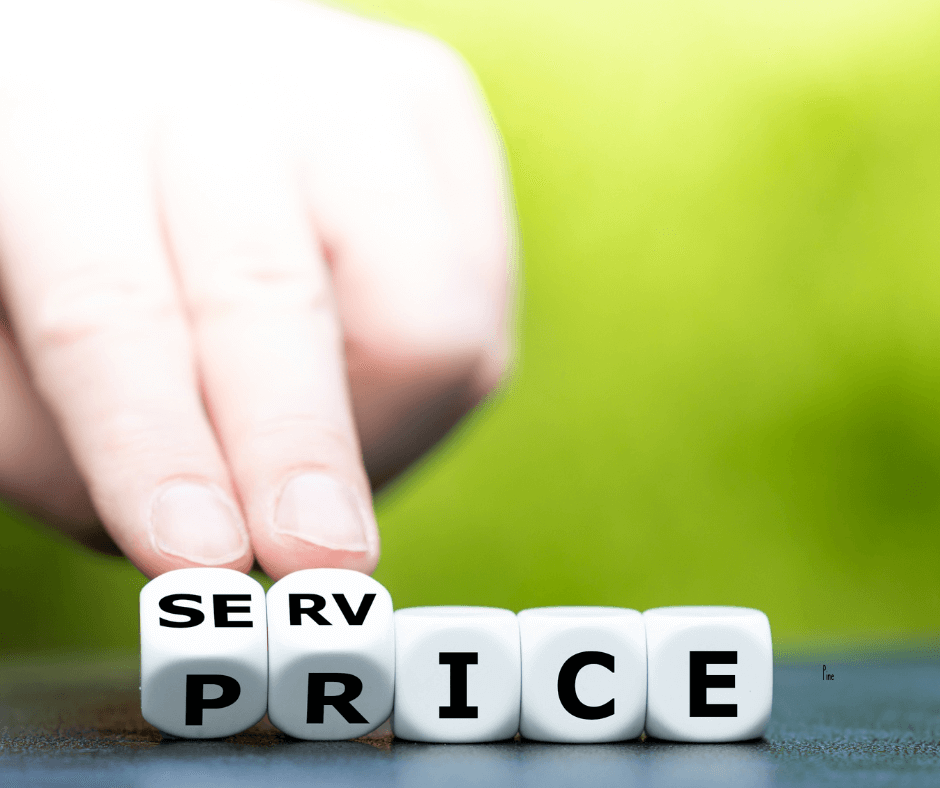How do you know what to charge for your lawn care services? Do you just call around and see what everyone else is doing and pick a number in the middle?
To determine what you should charge your customers for you your services, you should check the competition. Also, Figure out your costs per service including fixed and variable costs, determine a goal for profit, and be somewhat flexible.
Start With Competitor Pricing
To figure out your ideal pricing, start with the range of competitor pricing. You will need several addresses for comparison. You need a lawn that will be a minimum charge. Usually this is 1,000 to 1,500. I am used to 2,000 as a minimum. Let's say you set your minimum as 1,500 sq ft. You will need a lawn that will measure less than that.
Then you will need one about 2,500, 3,500, 5,000, 10,000, and 15,000. You can use more sizes but this should tell you what you need to know. Plot out the prices you receive for the various sized lawns and then fill in the blanks for the other sizes. Then, be sure to get the price for your average lawn size in your area.
General Practices
For most lawn care companies, the price goes up a set amount for each 500 square feet. Most computer software for lawn care is set up to figure prices based on square footage. Most often, there are commonly price breaks for larger properties. The break point where the price per square foot starts going down depends on preference, overhead costs, and the average size of the lawn in the area.
In general, the first price break is at 10,000 square feet. If you are charging $6.00 per 1K square feet, you would drop the price to say $5.50 per 1,000 square feet. If your minimum is $40 for 1.500 sq ft and you go up $6 per sq ft then your price for 2,000 ft would be $43, for 3,000 $49, etc. At 10,000 sq ft the price would be $ 91, but at 10,500 it would be $93.75 , with the decrease in price for the 500 feet after 10K. ($91 plus half of $5.50).
There is often another price break at 15K sq ft. This could be another $.50 or $.25 depending on competition. You can also set a fixed price for an acre (43,560 ft) and figure price on a percentage of acre after a certain amount of square feet. For example, the price rises $3 for every 500 feet until you reach 15,000 square feet then you use $300 an acre as a base for lawns over 15K.
For example, a lawn measures 25,000 square feet. You would divide 25 by 43.56 and get .574 of an acre. .574 times $300 and their price would be $172.17 per service.
Price Based On Expenses and Profit
Obviously you can't just say that you need to average $500 per customer to cover your expenses and make 30% profit, but you do need to make sure you are making money and all your work is going to pay off. You need to start with a good budget.
There are several good budget tools or you can just start with Excel and make your income and expense columns. We will work on budgets and budget planning in other blog posts but we can talk about theory.
Besides having a basic yearly budget, you should have a spreadsheet with the last 2 years of I and E numbers, your current year budget, and at least one more year ahead budget. This is 2019 so you should have a budget planning sheet that has your income and expenses for 2017, 2018. 2019, 2020. and 2021. These should include both fixed and variable costs.
The two future years should include any payments for equipment purchases, additional salaries for staff expansion, or any other upgrades that will be needed to handle the increase in customers. You can spend days and days figuring all this out down to the dollar or you can just decide on a planned increase and use that percentage increase across the board and then tweak the results.
For example, you had 500 customers in 2018 and your plan is to have 750 customers in 2019. This is a 50% increase in customers. You would apply a 50% increase to your variable expenses like products, gasoline, and labor. You fixed expenses like rent and utilities would mostly stay the same unless you would have to add a vehicle or a tech or additional equipment payments. That is where you would tweak your numbers.
Pricing On Profit
After your 5 year budget is completed, make sure you are bringing in enough money to stay in business. Then you will need to work on another budget sheet. This sheet should break down your product costs per service. Also, it should compare the amount of money you are spending on products to the amount of money you are receiving per 1K square feet. Your product costs should be 11% to 20%. Commonly, this is dependent on years in business, region of the country, equipment being used, skills of employees, etc.
For example, Service 1 you are using Prodiamine, Atrazine, and Trimec. Prodiamine will be blanket sprayed at a cost of $0.30 per 1K sq ft and The Atrazine and Trimec will be applied to weeds at a guestimate of 30% of per coverage.
The product cost is $0.40 per sq ft times 30% of turf coverage so your average cost is $0.12 per sq ft for weed control. Your total cost of products for Round 1 is $0.52. You are charging a minimum of $43 plus $6 per 1K sq ft so this is definitely a profitable service.
Adjusting product costs is one place you can increase profit without raising prices. We will address other ways to cut expenses but for now, lets go back to setting prices.
Decide On Pricing
Armed with the low and high range of your competitors and your budget, you can make an informed decision about the prices to set when you first start out. I suggest choosing a price in the middle for your first year. Remember you will have to offer a deal on the customers first service to match almost all competitors. This is usually a price around 50% off of the first or last service.
Setting your pricing up at the high end, you are comparing yourself with high end companies. These companies usually offer special services, professional evaluations, nice looking website, marketing, logos, uniforms, office employees with good customer service skills, etc.
Low end competitors usually have poor reviews and tend to have policies that customers don't like including impersonal service, constant upselling, contracts, and poor customer service.
We will talk more about finding your niche and developing your story "Why customers should choose you". Until you find your place in the market, don't be the cheapest and don't be the most expensive. Pick the middle and make the budget work.
You will loose some leads to lower priced companies and you will sell some leads because you will be cheaper than others they have called. It will even out. Eventually, your reputation and reviews and referrals will kick in and people will sign up with you. Even if you are a little higher priced than other companies, repuation will sell your company.
Be A Little Flexible
Lastly, your price doesn't have to be set in stone. If leads are telling you that they want to use your company but you are $3 more per service, are you really going to let them walk for $24? You can make that up quickly with an upsell or keeping them until next year. If you are like most companies you spent at least $50 to get that lead. You can't let it go away for a few dollars.
i suggest having a policy that you will be flexible about 10% without question. Have the customer send you their quote or invoice from the other company and either meet their price or be flexible to reduce your price 10%. Sometimes customers are willing to meet you half way between your normal price and the price they received from another company.
Be sure to explain all the advantages of going with your company and the offer a compromise and usually that will work. This is a win-win situation that can lead to a customer that will purchase more services from you and continue to be a loyal customer for years.


